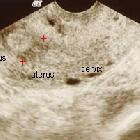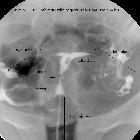Asherman-Syndrom


Asherman syndrome, also known as uterine synechiae, is a condition characterized by the formation of intrauterine adhesions, which are usually sequela from injury to the endometrium, and is often associated with infertility.
Epidemiology
There is a tendency for the condition to develop soon after pregnancy (usually within four months ). The incidence is thought to be increasing probably as a result of increased use of intrauterine interventions.
Clinical presentation
Patients may present with infertility, pregnancy loss, menstrual abnormalities (e.g. 2 amenorrhea, hypomenorrhea, dysmenorrhea) or abdominal pain .
Pathology
Intrauterine adhesions result secondary to trauma to the basal layer of the endometrium with subsequent scarring. This may be from a previous pregnancy, dilation and curettage, surgery, or infection (e.g. TB endometritis).
The adhesions are composed of fibromuscular-connective tissue bands with or without surrounding superficial epithelial cells or glandular tissue.
Radiographic features
Hysterosalpingogram
Intrauterine adhesions are typically seen on HSG as multiple irregular linear filling defects (may give a lacunar pattern), with the inability to appropriately distend the endometrial cavity . In severe cases, there can even be complete non-filling of the uterine cavity.
Ultrasound
- sonohysterography can demonstrate hyperechoic band adhesions across the uterine cavity
- 2D transvaginal ultrasound, suggestive features
- interrupted endometrial line in sagittal plane
- punctate echogenic foci in the endometrium
- indistinct endomyometrial junction
- indistinct endometrium or thin endometrium (<6 mm) that doesn't increase with hormonal therapy despite normal ovaries and hormonal profile
- endometrial fluid: commonly loculated appearing as small focal cystic areas within the endometrium
- hyperechoic lesion without posterior shadowing reflects fibrosis and if with posterior shadowing reflects calcifications
- 3D transvaginal ultrasound, suggestive features
- irregular endometrial cavity outline in coronal plane
- decreased endometrial thickness (<2mm)
- interrupted endometrial line
- undetectable endometrium suggests extensive adhesions
- narrowing of endometrial cavity: transcornual diameter <20 mm and midcavity diameter <10 mm
MRI
The adhesions are usually low signal on T2.
Treatment and prognosis
The goal of therapy is to remove adhesions and subsequently restore the normal size and shape of the uterine cavity. This is most commonly done by lysis of adhesions via hysteroscopy . The reproductive outcome correlates with the type of adhesions and extent of uterine cavity occlusion.
History and etymology
The condition was initially described by Joseph Asherman in 1948 .
Differential diagnosis
On a hysterosalpingogram consider:
- normal intrauterine longitudinal folds in a non-distended uterus may sometimes mimic uterine synechiae
See also
- amniotic sheets: uterine synechiae occurring in pregnancy
- amniotic band syndrome
- intrauterine membrane in pregnancy
Siehe auch:
und weiter:

 Assoziationen und Differentialdiagnosen zu Asherman-Syndrom:
Assoziationen und Differentialdiagnosen zu Asherman-Syndrom:

